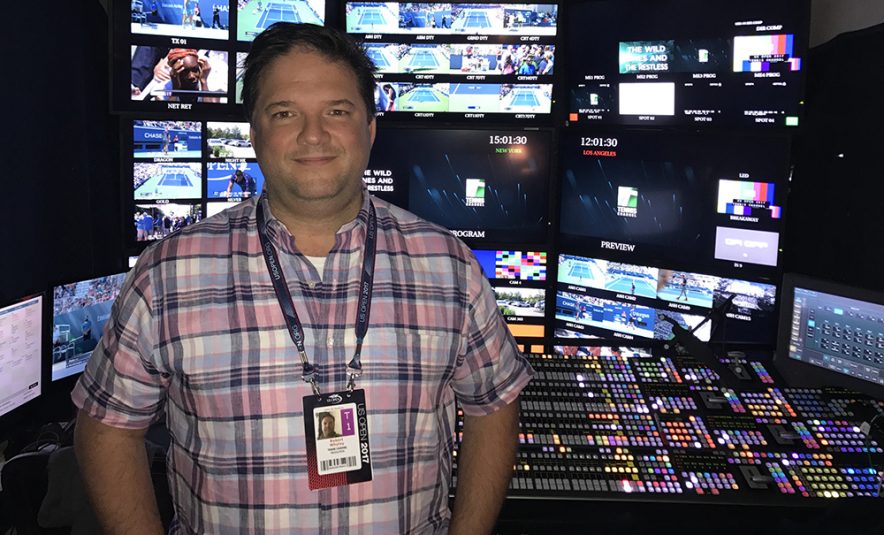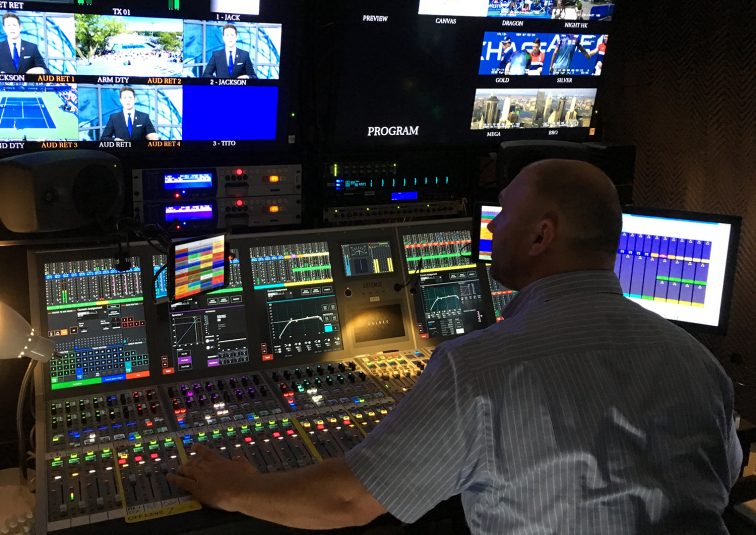Live From the US Open: Tennis Channel Continues To ‘Tell the Story of Tennis’ With Live Studio Programming
Sinclair Broadcast’s Avid Interplay remote kit, VER’s flypack boost operations
Story Highlights
Although the US Open is one of the highest-profile events on the annual tennis calendar, for Tennis Channel, it’s just another high point on a non-stop schedule of court coverage.
“This is just like Week 36 of the tennis season for us, because we’re telling the story of tennis beginning on Jan.1 in Week 1 through the end of the year,” says Bob Whyley, SVP, production/executive producer, Tennis Channel. “We’re already telling the story of tennis year-round, and this is just a much bigger extension of that. The US Open is an opportunity to concentrate on doing what we do best, and that’s telling the story of tennis.”
Although the Tennis Channel does not hold rights to live matches at the US Open, the network is producing more than 175 hours of total US Open coverage, including live studio programming from onsite. In addition to the Tennis Channel Live at the US Open morning show (8-11 a.m. ET Aug. 28-Sept. 6) and one-hour evening program US Open Daily (from its signature set at Arthur Ashe Stadium), Tennis Channel is once again airing late-night and early-morning match encores called by its star-studded team of on-air talent.
Avid Remote Infrastructure Serves At-Home Production
For the first time at the US Open, Tennis Channel is deploying Avid Interplay remote infrastructure to share content between the onsite operation at the USTA Billie Jean King National Tennis Center (NTC) in Flushing, NY, and its headquarters in Culver City, CA. The workflow, which debuted at the BNP Paribas Open at Indian Wells in March, builds on the system developed by Tennis Channel owner Sinclair Broadcast Group for news-sharing needs at its 200-plus stations across the country.
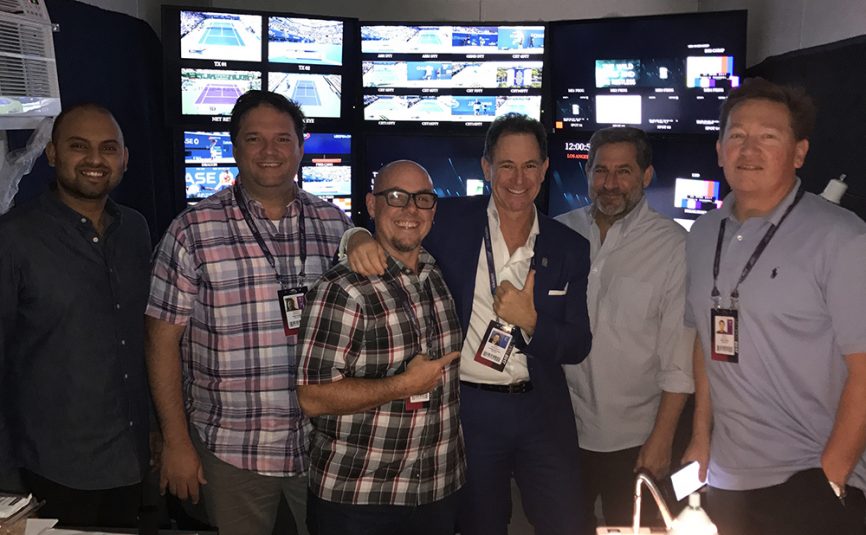
Inside the Tennis Channel control room at the National Tennis Center with the production team, including Bob Whyley (second from left) and Tennis Channel President Ken Solomon (third from right)
“Sinclair uses this every day to transfer news content back and forth between all their stations,” says Michael Forman, technical producer, Tennis Channel (and VER employee). “It’s obviously being used in a new way because we’re a sports network. It’s not quite the same application, but we have the same basic principles in terms of how content is used and shared.”
Tennis Channel is capable of transferring content via a dedicated 300-MBps data path, allowing upwards of 2 TB of data to be transferred per day from the Open. The Avid Interplay facility onsite, housing three Media Composer edit suites, connects to a similar setup in Culver City (featuring two dedicated edit suites). Users at the NTC can view proxies of Culver City-housed content and automatically request necessary hi-res content to be transferred.
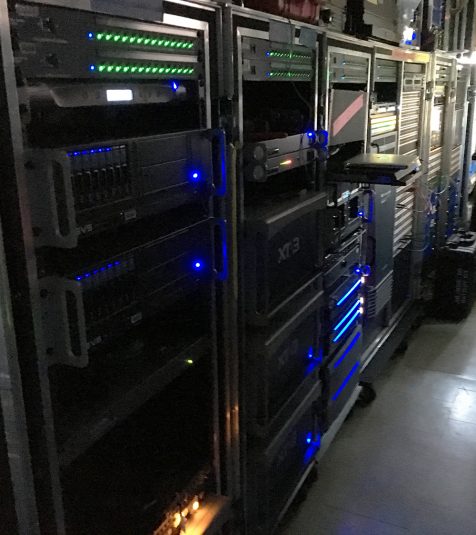
Tennis Channel again called on VER to assemble a flypack unit inside a trailer at the NTC for its US Open production.
“This has been an amazing tool for us, and now we are just trying to figure out how to maximize the usage of that tool,” says Forman. “It is not even a year old for us, so it’s pretty infantile, but it’s already working very well.”
VER Flypack Returns to the US Open
Tennis Channel has once again rolled in a production flypack, built by VER, inside a trailer on hand at the NTC. The broadcaster relies on VER to provide the bulk of its facilities at all Grand Slam events (at Roland Garros, it produces 10+ hours per day of live coverage), as well as at several stateside tournaments throughout the year.
“When you look at the amount of content that comes out of this little control room here, it’s pretty amazing,” says Whyley. “We’ve also got a lot going on in terms of our [studio shows], features, and interviews on the production side. We do the three-hour Tennis Channel Live in the morning, then take an hour break, then produce US Open Daily, which airs on tape delay at 11:00 at night. So the same crew and the same facility are producing four hours of content out of here.”
The production is built around a 5M/E, 80-input Grass Valley Kayenne K-Frame switcher and Nvision 8280 router (256×577). On the replay side, Tennis Channel has three EVS XT3 replay servers (6 In/2 out but licensed for 12 channels), three EVS XFile3 archive units, and two EVS XTAccess systems.
The show’s audio is being mixed by a Calrec Beam (40-fader) audio console and features Calrec Hydra2 audio networking.
Other equipment includes 18 Evertz VIP 16 multiviewers, 60 Cobalt UDX frame syncs, 21 AFP fiber transports with mux, 102 TB worth of Harmonic data storage, an RTS ADAM frame intercom system, and a DTC wireless camera system with Video Sys remote camera control.
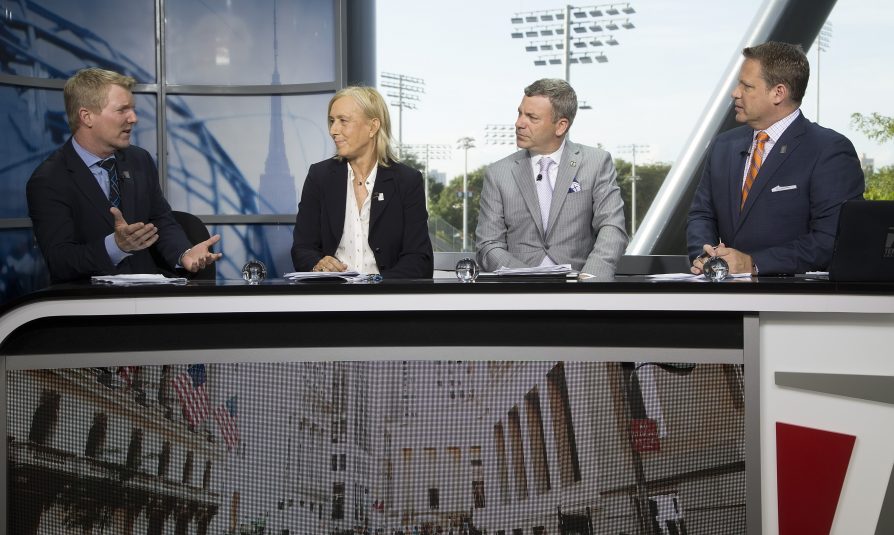
Tennis Channel’s Jim Courier, Martina Navratilova, Jon Wertheim, and Brett Haber on the set of “Tennis Channel Live at the US Open”. Credit: camerawork usa/Fred Mullane.
The studio set at Arthur Ashe Stadium, where most of Tennis Channel’s programming originates, is covered by all Sony HDC-4300 4K-capable cameras for the first time this year.
“We love our set, and, since we’ve been using essentially the same commentators year-round, we are very comfortable,” says Whyley. “If you watch our [studio programming], you’re going see a group of people in front of the camera and behind the camera that are more comfortable in telling the stories of tennis. It’s a live three-hour pregame show and an hour daily show at night that are just for tennis, and we take a lot of pride in that because you won’t find that anywhere else.”
